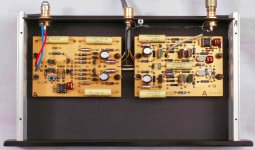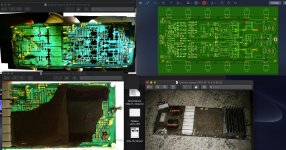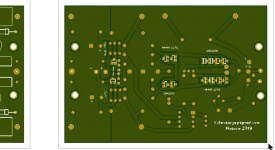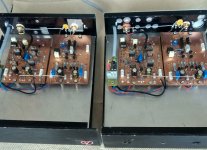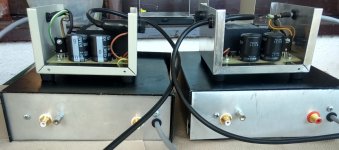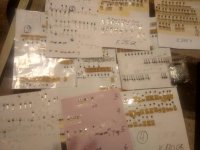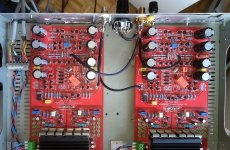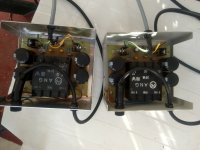Tell me, give advice!
There is an SMD analog-replacement -
1-J203 (2sk209 smd-???? can i apply)
2-J112
3-J175........
There is an SMD analog-replacement -
1-J203 (2sk209 smd-???? can i apply)
2-J112
3-J175........
John Curl is not probably delighted with your project. He wishes to keep design details as a secret. And your fake J-Fets will give you wrong results since they have different gain, noise and Vgs Off compared to originals.
There are a lot of photos on the Internet - this is no longer a secret! I repeated the photo of the board.This forum is watched by few people! I do not think that this forum thread will change or affect something.
Last edited:
Did you make PCB-s with photo resist coated epoxy boards? In this case you may attach black and white PCB patterns in pdf, 1:1.
no epoxy coating--Vendetta
I once opened the board and with epoxy resin again there)))
vendetta for me a simple task)))
I use the last project ---SMD
1-(sk170/j74)---smd sk209/mmbfj270
2- (J203 )---smd-mmbfj203
other transistors are available
I have not found any other analogues SMD.
j112
j175
2sk213
2sj76
I would collect a small fee
I like the result with fake transistors - the sound is still very good.
One problem. with direct current. I can decide to put it on the output of 1 mf capacitor and that's it!
I once opened the board and with epoxy resin again there)))
vendetta for me a simple task)))
I use the last project ---SMD
1-(sk170/j74)---smd sk209/mmbfj270
2- (J203 )---smd-mmbfj203
other transistors are available
I have not found any other analogues SMD.
j112
j175
2sk213
2sj76
I would collect a small fee
I like the result with fake transistors - the sound is still very good.
One problem. with direct current. I can decide to put it on the output of 1 mf capacitor and that's it!
Attachments
Last edited:
AN-1651 is now at TI: https://www.google.com/url?sa=t&rct.../pdf/snaa046&usg=AOvVaw3_4pe8vUaJ-Zt2A0wRAMRoHi Raymond,
there are more than one way to do the RIAA equalization. These ways are topologies that uses networks to correct the RIAA standard and these networks may to be all active eq., or all passive eq. or a mix of them.
The Vendetta´s pre-preamp ( front-end stage ) uses passive network for 2120Hz correction. The others networks it uses active equalization ( feedback loop ) on the second stage.
For more details about these topologies please read this http://www.national.com/an/AN/AN-1651.pdf
regards
eD
I decided to build SCP2B version which is not phase inverting compared to A . I am very glad I become a Vendetta owner. It works perfectly, no hum, extremely low noise . Noise is as low as in Paradise phono which I also built, but I prefer Vendetta which is more neutral and has more low level details. All the Fets are genuine Toshiba-s, MOS fets are Hitachi laterals. Matched, identical values on both channels. It is necessary since first stage is no feedback gain block. DC servo is very effective, offset is 0.5mv.
Very complex project, but I have already built Borbely 804-419 phono stage which is in some aspects similar to Vendetta.
Very complex project, but I have already built Borbely 804-419 phono stage which is in some aspects similar to Vendetta.
Attachments
Last edited:
kamis:
very nice work! i've been a borbely fan for many years. what listening differences have you observed between your "kamis-vendetta" and your borbely 804-419? (not asking which is better; at this level, that question doesn't make a lot of sense to me.🤐)
very nice work! i've been a borbely fan for many years. what listening differences have you observed between your "kamis-vendetta" and your borbely 804-419? (not asking which is better; at this level, that question doesn't make a lot of sense to me.🤐)
Borbely 804-419 is a very compact all-fet MC and MM phono preamp with on-board high quality series low noise regulators. Topology is similar to Vendetta - complementary and dual complementary differential inputs. RIAA filter topology is the same- passive HF eq. and active bass boost in the second stage. First stage has feedback compared to Vendetta which is without feedback and noise making feedback resistors.
Some aspects of Vendetta design are more elaborate than Borbely. Low noise local regulators are one of the secrets of Vendetta better sound reproduction. Vendetta is more refined, with better dynamic swing. Much better than my Xono version which I sold.
My second best phono preamp is Paradise phono. Less defined than Vendetta with softer bass reproduction.
Some aspects of Vendetta design are more elaborate than Borbely. Low noise local regulators are one of the secrets of Vendetta better sound reproduction. Vendetta is more refined, with better dynamic swing. Much better than my Xono version which I sold.
My second best phono preamp is Paradise phono. Less defined than Vendetta with softer bass reproduction.
Attachments
There is Vendetta D version where round diode bridges are replaced with soft recovery diodes. Instead of replacing bridges I decided to measure snubber network with scope and cheapomodo device designed by our forum member Mark Johnson. I soldered it under the PS pcb-s. The whole sound picture is now slightly more focused.
Attachments
It's a source follower, sometimes fancifully called a cap mux, with a regulated gate voltage.I wouldn't call them capacitance multipliers as they work similar to regulators. "Raw" dc comes from a pair of 3-terminals and the resistor divider (missing 10k and 100k) provides a fixed voltage at the gates. A better example is the input board where the resistor is replaced with a CCS.
As this is likely not the only error i'll do all corrections later.
The output is definitely not regulated. That would anyway be against JC's religion ;-).
Jan
- Home
- Source & Line
- Analogue Source
- A real Vendetta?
